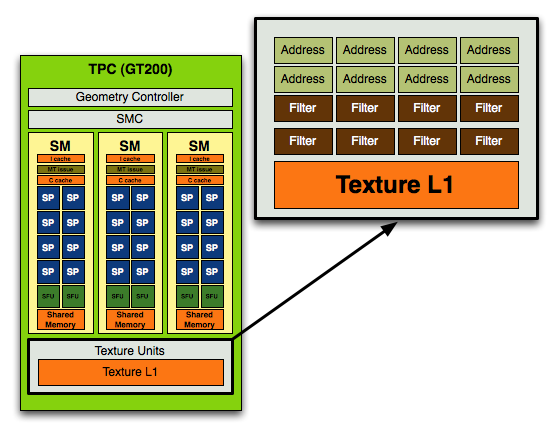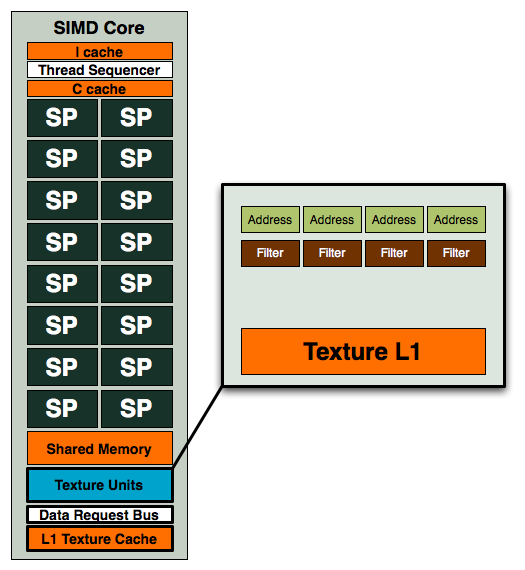The Radeon HD 4850 & 4870: AMD Wins at $199 and $299
by Anand Lal Shimpi & Derek Wilson on June 25, 2008 12:00 AM EST- Posted in
- GPUs
That Darn Compute:Texture Ratio
With its GT200 GPU, NVIDIA increased compute resources by nearly 90% but only increased texture processing by 25%, highlighting a continued trend in making GPUs even more powerful computationally. Here's another glance at the GT200's texture address and filter units:

Each TPC, of which there are 10, has eight address and eight filter units. Now let's look at RV770:

Four address and four filter units, while AMD maintains the same 1:1 address-to-filter ratio that NVIDIA does, the ratio of compute-to-texture in RV770 is significantly higher.
| AMD RV770 | AMD RV670 | NVIDIA GT200 | NVIDIA G92 | |
| # of SPs | 160 | 64 | 240 | 128 |
| Texture Address/Filter Units | 40 / 40 | 16 / 16 | 80 / 80 | 64 / 64 |
| Compute to Texture Ratio | 4:1 | 4:1 | 3:1 | 2:1 |
The table above illustrates NVIDIA's trend of increasing the compute to texture ratio from 2:1 in G92 to 3:1 in GT200. AMD arguably overshot with RV670 and its 4:1 ratio and thus didn't need to adjust it with RV770. Even while staying still at 4:1 with RV770, AMD's ratio is still more aggressively geared towards compute than NVIDIA's is. That does mean that more texture bound games will do better on NVIDIA hardware (at least proportionally), while more compute intensive games may do better on RV770.
AMD did also make some enhancements to their texture units as well. By doing some "stuff" that they won't tell us about, they improved the performance per mm^2 by 70%. Texture cache bandwidth has also been doubled to 480 GB/s while bandwidth between each L1 cache and L2 memory is 384 GB/s. L2 caches are aligned with memory channels of which there are four interleaved channels (resulting in 8 L2 caches).
Now that texture units are linked to both specific SIMD cores and individual L1 texture caches, we have an increase in total texturing ability due to the increase in SIMD cores with RV770. This gives us a 2.5x increase in the number of 8-bit per component textures we can fetch and bilinearly filter per clock, but only a 1.25x increase in the number of fp16 textures (as fp16 runs at half rate and fp32 runs at one quarter rate). It was our understanding that fp16 textures could run at full speed on R600, so the 1.25x increase in performance for half rate texturing of fp16 data makes sense.
Even though fp32 runs at quarter rate, with the types of texture fetches we would need to do, AMD says that we could end up being external memory bandwidth bound before we are texture filtering hardware bound. If this is the case, then the design decision to decrease rates for higher bit-depth textures makes sense.
| AMD RV770 | AMD RV670 | |
| L1 Texture Cache | 10 x 16KB (160KB total) | 32KB |
| L2 Texture Cache | I can has cache size? | 256KB |
| Vertex Cache | ? | 32KB |
| Local Data Share | 16KB | None |
| Global Data Share | 16KB | ? |
Even though AMD wouldn't tell us L1 cache sizes, we had enough info left over from the R600 time frame to combine with some hints and extract the data. We have determined that RV770 has 10 distinct 16k caches. This is as opposed to the single shared 32k L1 cache on R600 and gives us a total of 160k of L1 cache. We know R600's L2 cache was 256k, and AMD told us RV770 has a larger L2 cache, but they wouldn't give us any hints to help out.










215 Comments
View All Comments
Amiga500 - Wednesday, June 25, 2008 - link
Apple has passed over control of Open CL to the Khronos group, which manage open sourced coding.To all intentions and purposes, it is open source. :-)
emergancyexit - Wednesday, June 25, 2008 - link
i hope you do 3x crossfire can do. maybe a 4x 4850 vs 3x GTX 260 just to satisfy us readers for the moment would be lovely!DerekWilson - Wednesday, June 25, 2008 - link
i'm not sure if this is supported out of the box ... ill have to check it out ...emergancyexit - Wednesday, June 25, 2008 - link
i would really like to know what type of performance theese cards could get in an MMO. (and hopefully compare them to some cheaper cards) Games im interested in are some of the newer titles like Age of conan ( i hear it's graphics are great and is a workout for even a 8800 ultra) And Eve-online (thier new graphics engine works cards pretty hard too)MMO's Graphics usually get pretty intesive with some odd 200+ characters flying around shooting fireballs evrywhere with missles sailing through the air in a land of hundreds of monsters as far as the eye can see. it can get pretty demanding on a gameing computer, just as much (if not more) as a hit new title.
for example, on my current Rig i can get around 50FPS steady at 1440x900 but on Eve-Online i get 35 at the most at peacefull times and 20 or even 15 in a large fight with FEW graphics options selected.
MIP - Wednesday, June 25, 2008 - link
Great review, the 4870 looks to be fantastic value. However, we're missing the 'heat and noise' part.skiboysteve - Wednesday, June 25, 2008 - link
Not only do these cards rock, but I wouldn't be surprised if AMD has an ace up its sleeve with the 4870x2... with that crossfire interconnect directly connected to the data hub that you showed on the chart. That and the fact that they have been looking forward to this crossfire strategy of attacking the high end for quite some time so they might have some tricky driver stuff coming with it.I have been disappointed with the heat and power consumption of these cards. But:
1) Someone said powerplay is getting a driver tweak and, I can always clock them lower in 2D than 500/1000 (which is insane for 2d)
2) That hardware site someone linked earlier showed a more than 50% reduction in temperatures with an aftermarket cooler! Thats insane!!
And finally, if I can get the 1 & 2 fixed... I want to know how well these babys overclock. If I can get a 4850 running like a 4870 or better... yum. And in that case, how high will a 4870 OC? And I want to know this with a non stock cooler, because apparently the stock ones suck. With a non stock cooler if the 4850 clocks up to 4870 level, but the 4870 clocks way up too... i'm gonna have to grab a 4870.
So yeah, fix #1 and #2 and find me non-stock cooler OC #s and I'll go buy one (maybe two?) when nehalem comes out
Powered by AMD - Wednesday, June 25, 2008 - link
Impressive review, Thanks :)A few glitches:
It says "Power Consumption, Heat and Noise", but the graphs only shows Power Consuption.
In Page 17 (The Witcher), in second paragraph, it says 390X2 instead of 3870.
Thanks again.
Cheers from Argentina.
Conscript - Wednesday, June 25, 2008 - link
atleast that was the tile of the second to last page...but only see two power consumption graphs?Proteusza - Wednesday, June 25, 2008 - link
I quote one Kristopher Kubricki regarding whether the RV770 is inferior to the GT200:"It is. Even AMD isn't going to tell you otherwise. You can debate this all you want, but it's still a $200 video card."
So, please tell me now why I should pay $650 for a GTX280. I'm struggling to see the logic here.
Source: http://www.dailytech.com/Update+AMD+Preps+Radeon+4...">http://www.dailytech.com/Update+AMD+Pre...50+Launc...
(near the bottom)
AbRASiON - Wednesday, June 25, 2008 - link
I can live with a greedier card than my 8800GT but I refuse to put up with a noisy machine.Any comments on the heat and noise please? would be nice!